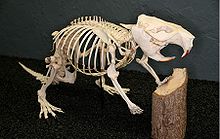
[Photo credit: Skimsta]
The advancement and development of skeleton of an animal depends on the animal's position in the evolutionary trend. For instance, man is able to stand erect than other organisms due to its sophisticated skeletal build-up.
FORMS/COMPONENTS OF SKELETON
There are three forms/components of skeleton:
- bones
- cuticles
- cartilages
- protein fibres (collagen)
- living bone cells (osteocytes)
- minerals, mainly calcium phosphate and calcium carbonate
The minerals makes up two-third (66.67%) of the mass of a bone. As a result, bone is more rigid and stronger than cartilage. A bone usually consists of shaft(hard outer layer) and hollow cavity, filled with bone marrow.
Bone is mainly present in vertebrates, e.g. snakes, mammals, birds, toads, e.t.c.
2. Cuticles: Cuticle is made up of protein called chitin and a thin water-proof layer of wax. Animals with cuticles can only grow by ecdysis or moulting, because chitin is a non-living substance. In the process of the growth, the organisms sheds off its old skeleton and put on a new one.
Cuticle is an exoskeleton - located at the external part of the body. Organisms with cuticles are mainly arthropods, e.g. insects, crabs, scorpion, e.t.c
3. Cartilages: Cartilages is a form/component of skeleton, usually found in the skeleton of complex vertebrates. It is made up of carbohydrates, protein fibres, and living cells (chondroblasts). It is tough and has great tensile strength. It cautions the effect of movement of one bone on another during movement. Organisms with cartilage are mammals and cartilagenous fishes like sharks.
Types of Cartilage
There are three types of cartilage present in mammals.They are:
- Hyaline cartilage: This is located in surfaces of movable joints; trachea and bronchi, which keep them open; and the protruding part of the nose.
- Fibro-cartilage: This is found in the disc between the small bones (vertebral) of the vertebra column. It is tougher than the hyaline cartilage.
- Elastic cartilage: This is located in the epiglotis and external ear (pinnae)
Differences Between Bone and Cartilage
Bone
|
Cartilage
|
It consists of living and
non-living cells
|
It consists of living cells
|
It is made up of hard substances
|
It is made up of soft substances
|
It is stronger and more rigid
|
It is less rigid and less strong
|
It can never be replaced by a cartilage
|
It can be replaced by a bone
|
It is not flexible, especially in adults
|
It is very flexible, both in adults and young ones
|
TYPES OF SKELETON
There are three main types of skeletons. These are:
- Endoskeleton
- Exoskeleton
- Hydrostatic(fluid) skeleton
1. Endoskeleton: Endoskeleton is the type of skeleton, found inside the body or internal part of an organism. It is made up of bones and cartilages in vertebrates. It is found in the skeleton of toads, fishes, lizards, birds and mammals. Endoskeleton in mammals consists of the skull, vertebral column or back bone, ribs, and bones of the limbs.
2. Exoskeleton: Exoskeleton is the type of skeleton, found outside the body or external part of an organism. Chitin is an example of exoskeleton because it commonly covers the outer parts of some animals. Most invertebrates(animals without backbone) possess cuticles, which consists of chitin.
Organisms with exoskeleton include invertebrates like Euglena, Paramecium, snails, insects, spiders, millipedes, crayfish, crabs, tapeworms e.t.c. Such organisms can only grow by a process called moulting or ecdysis.
3. Hydrostatic(Fluid) Skeleton: This is the type of skeleton, which is possessed by soft-bodied animals. They have fluid pressure to provide support. Fluid is secreted to fill the spaces in the body. The fluid presses against the muscular body wall, causing the muscles to contract, exerting pressure against the fluid. This helps to maintain the shape and form of the animal.
Organisms with this type of skeleton include earthworm and anemones.
Read futher: The Skeletal System:
Axial skeleton
Appendicular skeleton
Read futher: The Skeletal System:
Axial skeleton
Appendicular skeleton








0 comments:
Post a Comment